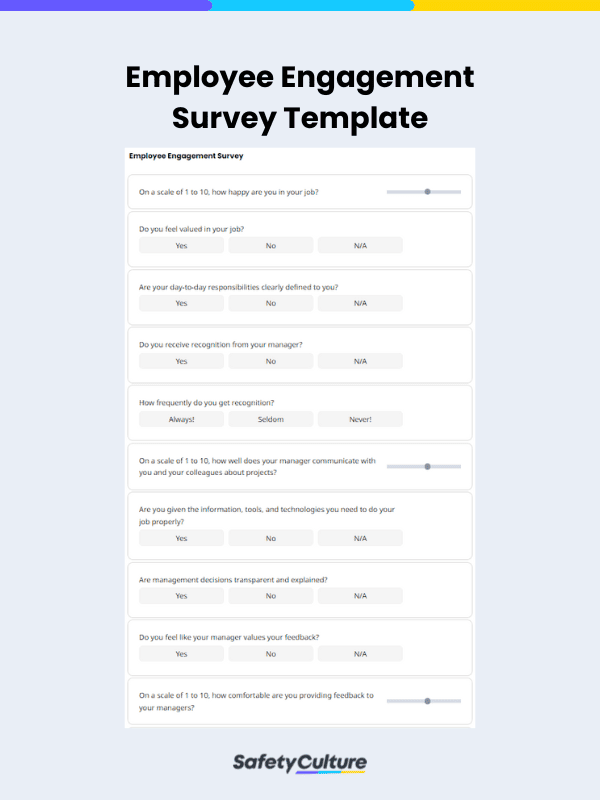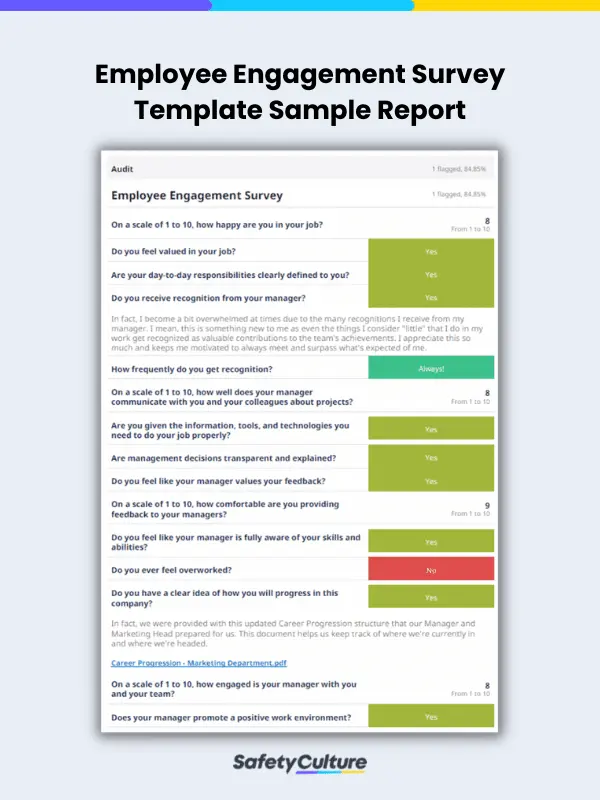What is an Employee Engagement Survey Template?
An employee engagement survey template is a Human Resources (HR) tool containing a pre-designed set of questions used to gather feedback from employees about their level of satisfaction, experience, and overall workplace engagement. This typically includes questions related to areas such as job satisfaction, career development, company culture, communication, and leadership to provide insights to organizations about how they can improve their programs and operations.
Importance and Benefits
Employee engagement surveys are crucial to maintaining a healthy workplace. These surveys are an essential tool for organizations to measure employee satisfaction and identify potential issues that can affect employee satisfaction and productivity.
Issues such as poor communication, lack of support, or inadequate training can lead to employee dissatisfaction and decreased productivity. Knowing these issues early on using surveys and templates allows organizations to take action to improve the situation and prevent further damage to employee morale and productivity.
Aside from that, the benefits of using an employee engagement survey template include:
- Standardization: A template provides a standardized survey that can be used across the organization. This ensures that all employees are asked the same questions and that their responses can be compared easily.
- Validity and reliability: A well-designed survey template ensures the validity and reliability of the survey results. This means that the survey accurately measures what it’s intended to measure and produces consistent results over time.
- Cost-effective: Using a pre-designed template can save organizations time and money in survey design and administration.
- Customization: While a template provides a standardized survey, it can still be customized to meet the specific needs of organizations. They can add or remove questions as needed to get the information they require.
- Actionable insights: An employee engagement survey template provides actionable insights that organizations can use to improve the workplace.
What to Include in One
The following are the key components and sections of an employee engagement survey template:
- Title Page – employee and manager details
- Survey Page – employee engagement survey questionnaire (multiple-choice and open-ended questions) on the following aspects:
- Job Satisfaction
- Communication
- Management
- Teamwork
- Culture
- Engagement
- Completion – sign-off
How to Create an Employee Engagement Survey Template
With the elements and sections you must include in an employee engagement survey template, here’s how you can create one that fits your organization’s needs:
- Communicate the purpose: Before conducting an engagement survey, it’s essential to let employees know why the survey is being conducted, what the organization hopes to achieve, and how the results will be used.
- Choose the right questions: The questions on an employee engagement survey should be relevant to the organization’s objectives and goals. These should be designed to measure the specific aspects of employee engagement that are important to the company. Avoid generic questions that won’t provide actionable insights.
- Plan the timing: Surveys should be conducted at regular intervals to measure changes in employee engagement over time. The timing of the survey should be chosen carefully to avoid periods of high stress, such as during peak workloads or organizational changes.
- Ensure anonymity: Employees should be assured that their responses will be kept confidential, and the survey should be designed to protect employee privacy.
- Provide feedback: Employees should know what actions will be taken based on the survey results and how the organization plans to improve employee engagement.
FAQs About Employee Engagement Survey Templates
Some of the most common challenges that organizations face when conducting employee engagement surveys are the following:
- Low participation rates, which can impact the validity of survey results
- Survey fatigue, especially when employees are asked to complete too many surveys
- Limited actions on results, which can demotivate employees from participating in such initiatives
- Biases in the survey design, which can impact the way employees will answer the questions
Since it’s one of the most common challenges, ensuring high participation rates in employee engagement surveys can be done through the following:
- Effective communication of the survey’s purpose and importance, anonymity, and the expected time commitment
- Strategic timing of the surveys (e.g., conducted during work hours with enough time to complete them)
- Motivational incentives such as gift cards, extra vacation time, and others
- Regular follow-ups to send reminders and provide assistance to employees in completing the survey
Once you’ve gathered enough feedback and insights from employees about their level of engagement, the next action is to analyze and interpret the results. To guide you, here are some steps you can take:
- Review the survey results.
- Identify areas of strength and weakness.
- Look for patterns and correlations in the data to identify drivers of engagement.
- Compare your company’s scores to industry benchmarks.
- Prioritize areas of concern and develop action plans with specific goals and deadlines.
- Consider creating cross-functional teams to address the issues.
- Track progress and measure results.




